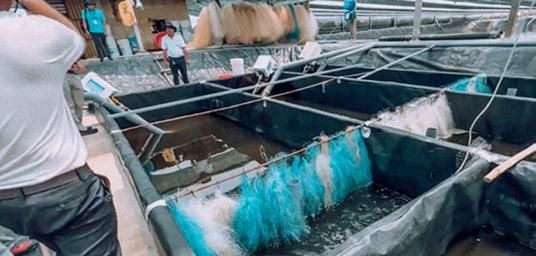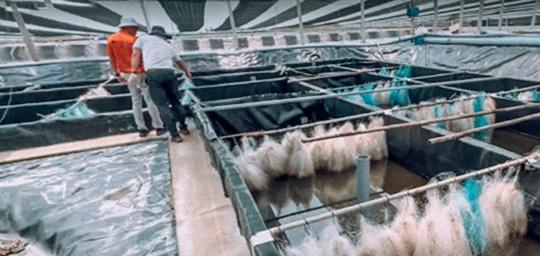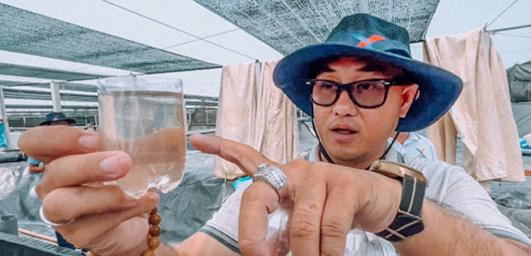
3 minute read
School Fish
from THE CRUST - ISSUE #9
by THE CRUST
Bootleg Recirculating Aquaculture System in Vietnam Shrimp Farm: A Simple Solution to Water Quality Management

In Vietnam, shrimp farming is a major industry that provides employment and economic growth for the country. However, the conventional methods of intensive shrimp farming have led to environmental degradation and water quality issues. Bad water quality can lead to emerging shrimp diseases in the water. Shrimp diseases, such as Enterocytozoon hepatopenaei (EHP) that’s found in particulates in the water, have been a significant challenge for shrimp production in Vietnam. This has led to decreased yields and increased costs for farmers.

One of the approaches that Vietnamese shrimp farmers use to mitigate this dire situation is RAS (Recirculating Aquaculture System). RAS is a closed-loop system that recirculates and treats water, reducing the need for water exchange. It helps maintain better biosecurity and control over water quality, crucial for shrimp growth. It results in better disease management and lower risk of infection. However, RAS is complex and expensive, requiring skilled labor and maintenance. Its electricity usage can increase the cost production of shrimp farming by up to 50%. This has prompted the development of the bootleg recirculating aquaculture system (RAS) as a simple solution to the problem.
The bootleg RAS is a low-cost and easy-to-use system that is designed to maintain water quality in shrimp farms. Vietnam’s Bootleg RAS design is like this: the RAS systems are placed on the available side of the pond by making a channel. The size of the RAS system is usually 5% of the shrimp Pond size and the channels were made into several smaller sections to place more mechanical filtration and increase the filtration effectiveness. fishnet then placed inside of each section and water pumps are placed in the last section for the water to be pumped back into the pond. This configuration does two things, helps polish the water to eliminate particulates in the water and creates biofilm which then helps control the ammonia and phosphate buildup in the water. One of the major benefits of the bootleg RAS is its simplicity. The system is easy to set up and operate. Fishnet can be easily taken out and cleaned while the water pump can be replaced or fixed for maintenance. The system also helps farmers in easily collecting waste sludge and eliminating it from the pond. This makes it ideal for small-scale farmers who may not have the resources or expertise to implement more complex systems. This means that farmers can build the system themselves, without having to rely on expensive equipment or outside expertise.
The use of minimal maintenance helps with the modularity of the system to be applied on each pond independently, compromising the whole operation for maintenance or biosecurity risk. Usually, RAS systems are one huge filter for the whole operation since separate filtration systems means higher investment and cost for production. but these can still pose a high risk for cross contamination and biosecurity risk that can hinder all of the production tanks. Vietnam’s bootleg RAS are applied individually for each pond, that means the risk of cross contamination is low and maintenance of each system won’t hinder all of the production site.
Another benefit of the bootleg RAS is its cost-effectiveness, not just from simple materials that are readily available in local markets, such as fish nets, but also the filtration system’s slow water flow that’s a key factor in its effectiveness in collecting sludge. This process allows the system to efficiently capture and remove particles, leaving behind clean water. Furthermore, the slow flow rate minimizes the risk of clogging and allows for longer periods of operation before maintenance is required. The Flow during the filtration time takes 1 hour Hydraulic Retention Time (HRT). With this design, Water is slowly and effectively filtered while electricity usage for the water pump is kept as low as possible. Using 5% RAS to pond Volume, in less than 24 hours, water in the pond can be fully recirculated to the filter ensuring that the water quality is maintained at all times. This system is so simple yet so effective in Vietnam, that reports of 70 tons per hectare with no partial harvest can be achieved. The system also helps with reducing water usage since the use of bootleg RAS helps with increasing water quality such as lowering the plankton in the water (thus eliminating the use of shading) and also reducing the amount of water changes. reportedly, Vietnam’s bootleg RAS design only adds water usually 3% a day just for water top up due to evaporation and also from the siphoning waste process which is amazing considering the simplicity of the system.
Overall, the bootleg RAS is a simple and effective solution to water quality management in Vietnam’s shrimp farming industry. Its ease of use and low cost make it accessible to smallscale farmers, while its simple design ensures that it can be implemented with minimal resources. As Vietnam continues to develop its aquaculture industry, the bootleg RAS may prove to be a valuable tool in promoting sustainable and environmentally responsible farming practices.







